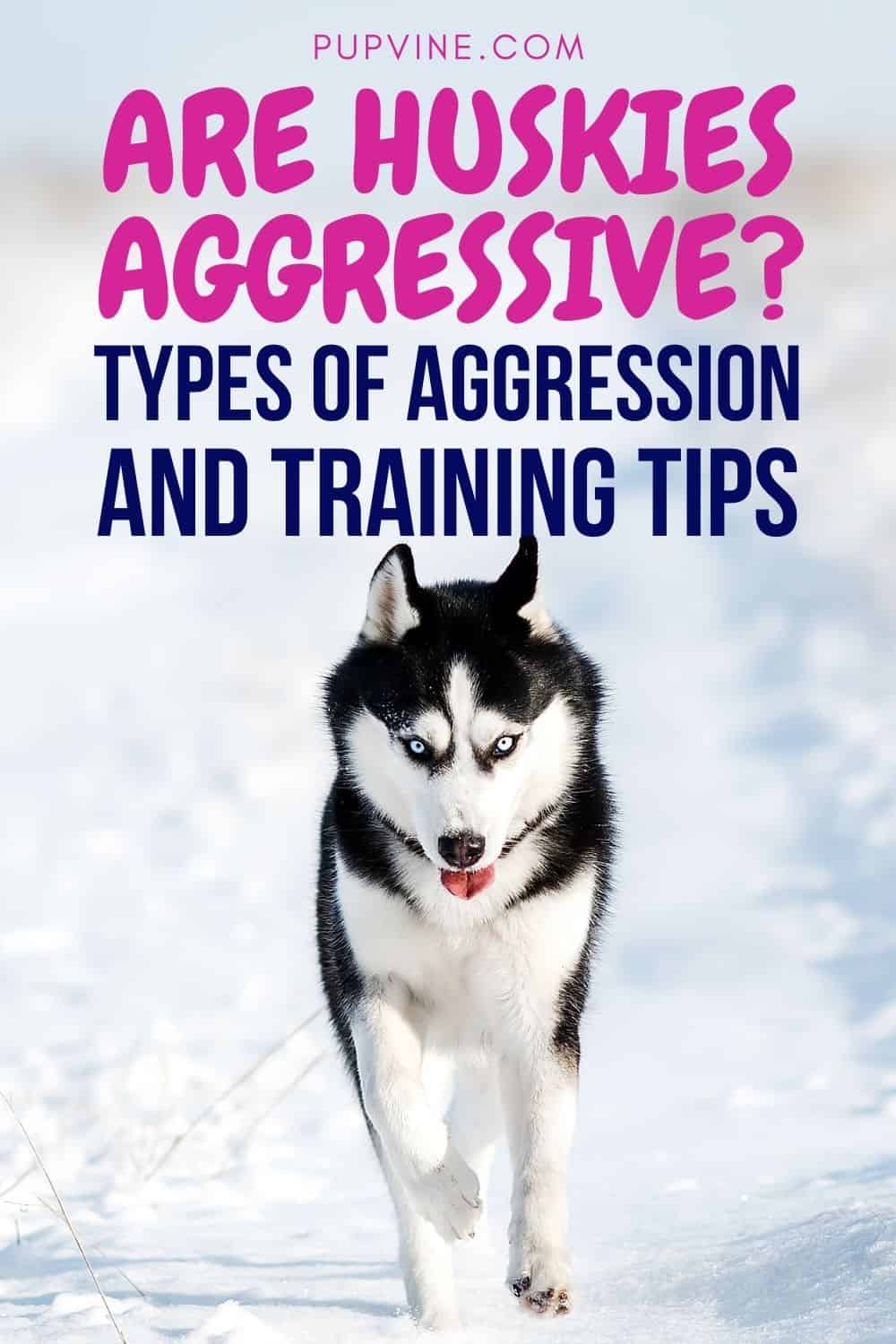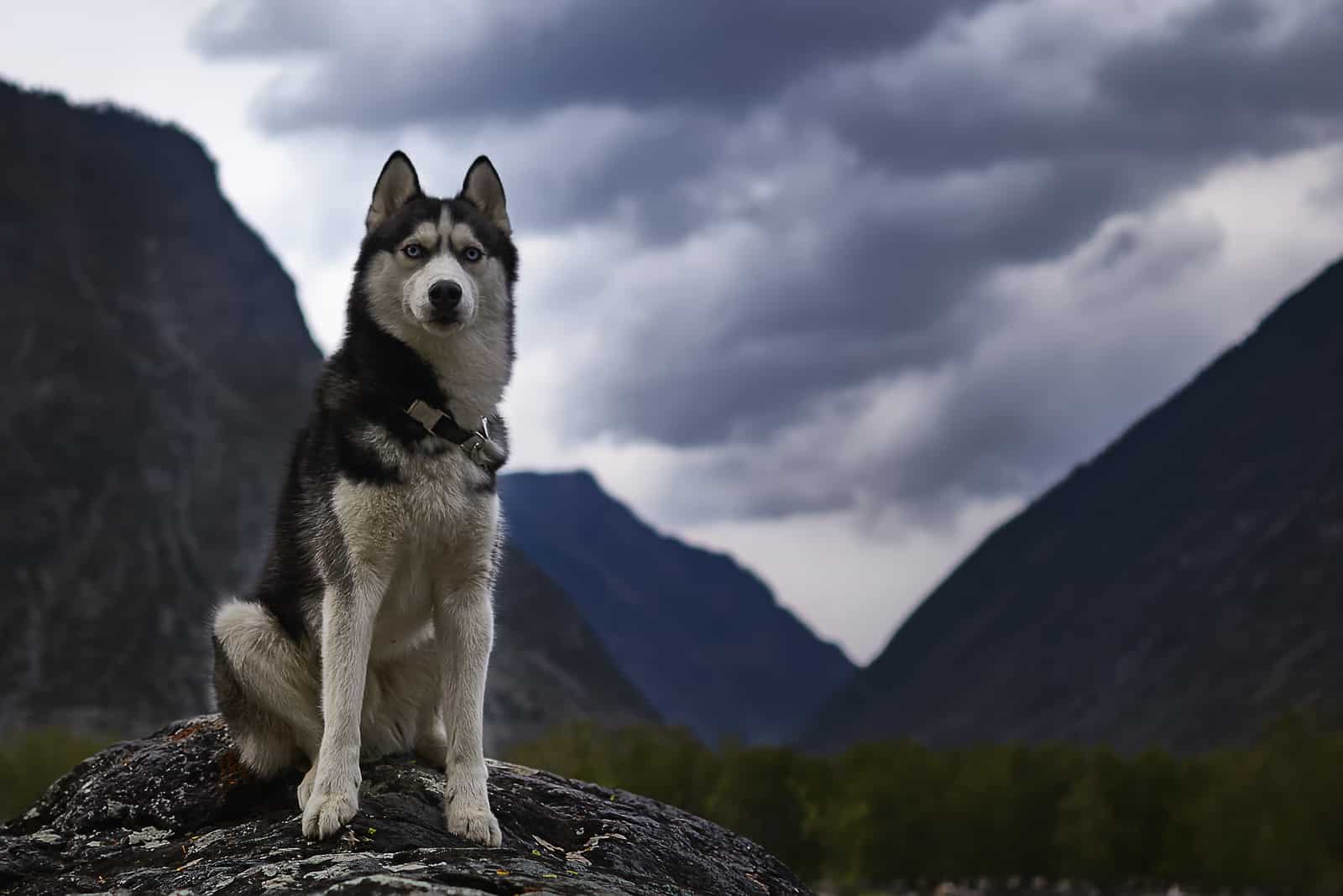While dogs are undoubtedly the most popular family pets, some dog breeds are still deemed aggressive. Pit Bulls, Cane Corsos, Akitas, and Rottweilers, for example, don’t have as good of a reputation as Labrador Retrievers or Corgis. Even Chihuahuas are known for their aggression!
But, what about Huskies? Can Husky be described as an aggressive dog breed?
These fairly large working dogs sport a wolf-like appearance, which can make people think these dogs are aggressive.
Aggression is a huge problem with dogs, and many aspiring dog owners worry about this – especially owners with small children. If you plan on getting a new pet, you need to understand its temperament and characteristics.
So, are Huskies aggressive?
Let’s look at all the possibilities!
Are Huskies Dangerous?
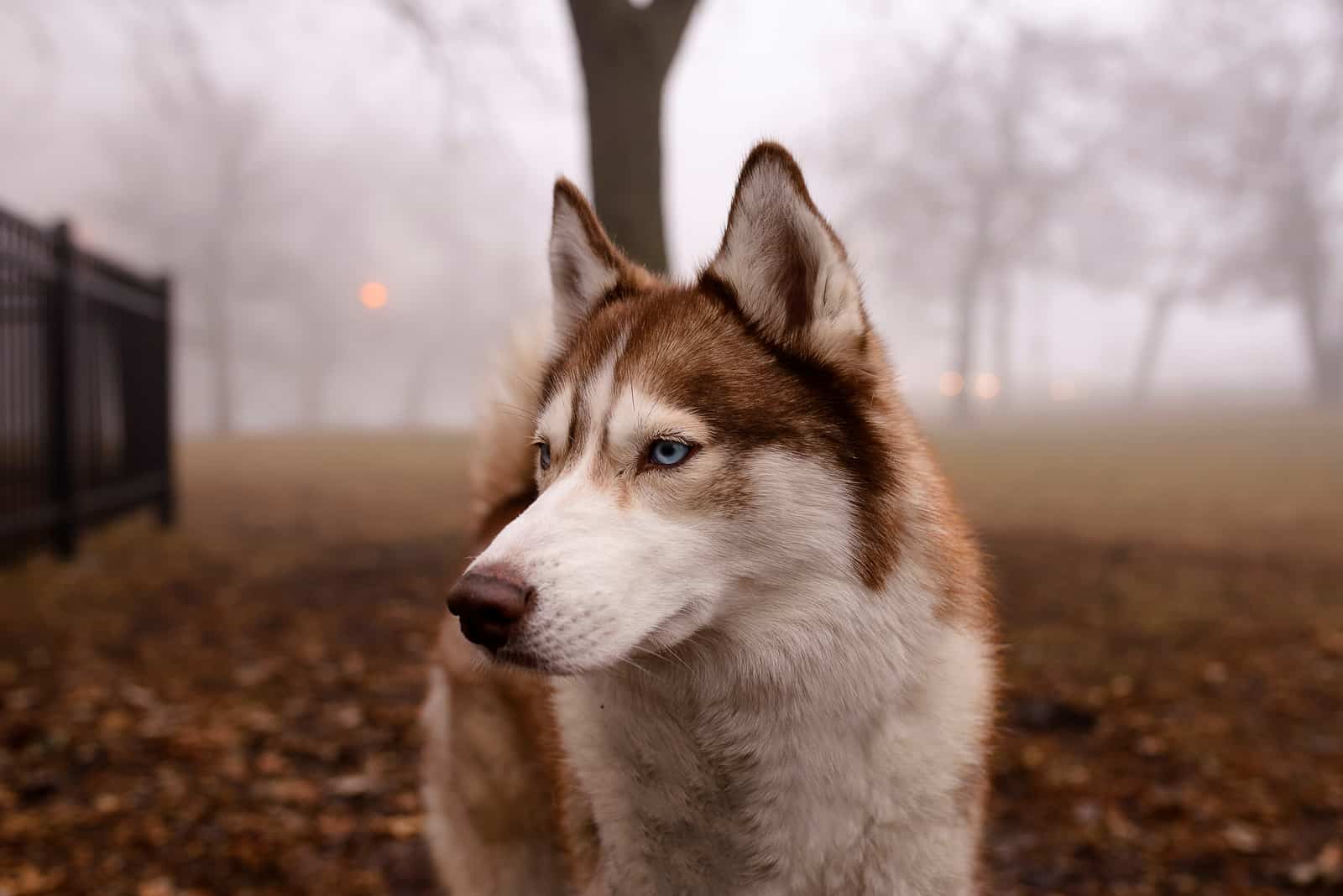
Siberian Huskies are not aggressive dogs. In fact, they are among the least aggressive dog breeds out there. Any Husky owner will confirm that these dogs rarely to never express any antisocial or aggressive behavior.
Huskies are very friendly dogs, even towards strangers. In fact, they are considered to be very bad guard dogs because of this trait. They aren’t likely to attack anyone. This makes them some of the best family pets out there.
A Siberian Husky is a good-natured, free-spirited dog that wants to befriend anyone.
With that in mind, it is important to place one disclaimer: All dogs might become aggressive if you neglect them or if you’ve failed to socialize them. How you train your dog and how you behave around him is more important than that dog’s genetics.
It is essential that you do all you can to ensure that your Husky puppy is brought up in a positive manner and that he is well-trained; otherwise, his mental health can be harmed. Even if this doesn’t happen, a dog that isn’t trained won’t know how to behave, especially not in the long term.
The Problem With Aggression
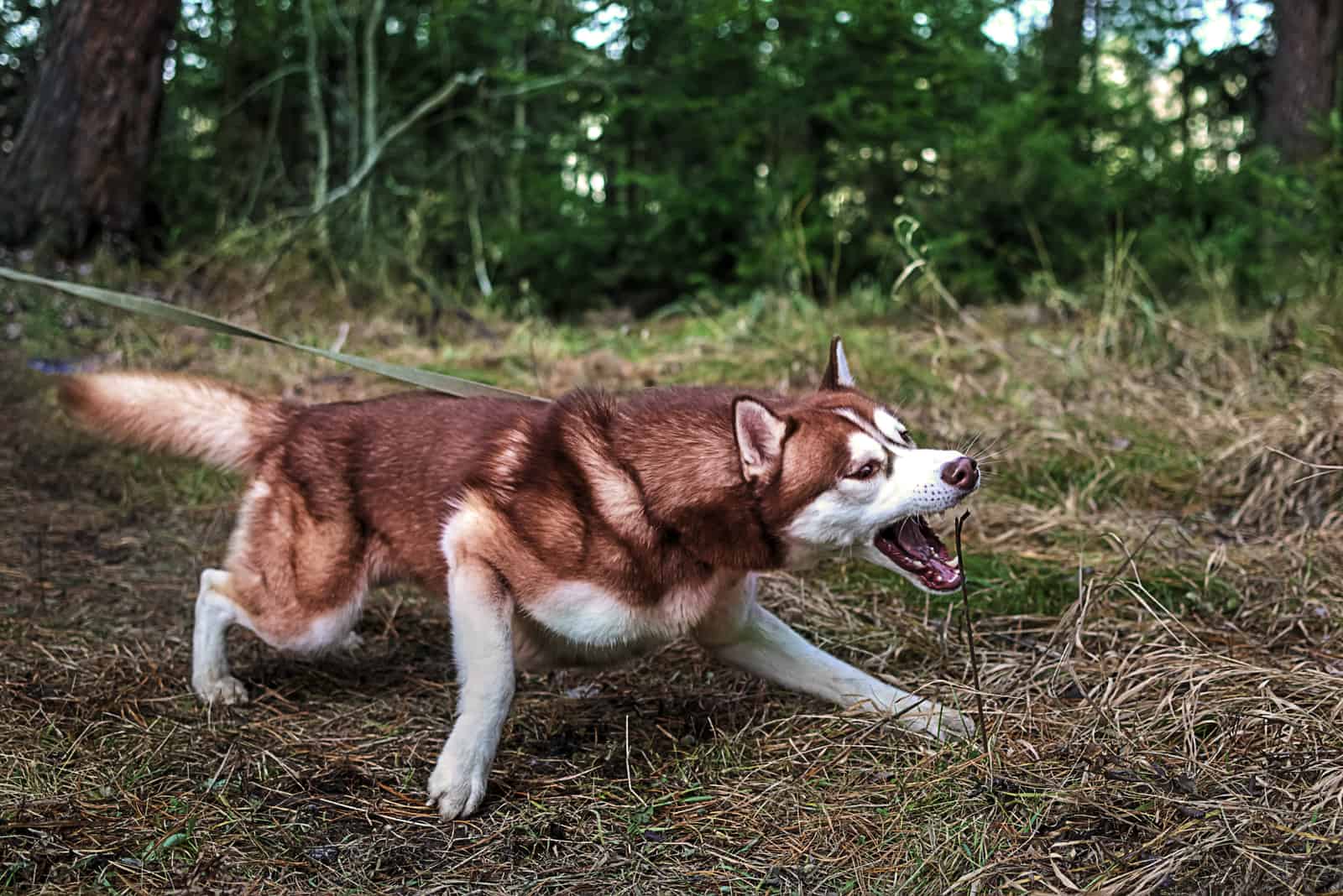
While you’ll rarely see an aggressive Husky, they might still express this trait if you failed with socialization.
Having an aggressive dog is not safe, no matter the breed. You can’t trust any aggressive dog, especially with children. The same goes for dog breeds that are normally good with kids, such as Siberian Huskies.
A dog that has aggressive tendencies can become very unpredictable. You may never know when it’ll lash out, lunge, or strike. This can reach a point where a dog owner becomes afraid of their own dog and might not want to be near him out of fear.
A Siberian Husky with aggression issues might be very friendly and playful at one moment – but the next minute, it could be growling and snapping.
There is usually a trigger behind these unpredictable mood swings, but you may not even be able to notice it at first. Sometimes, even you might be the cause of the trigger without realizing it.
Why Are Siberian Huskies Aggressive?
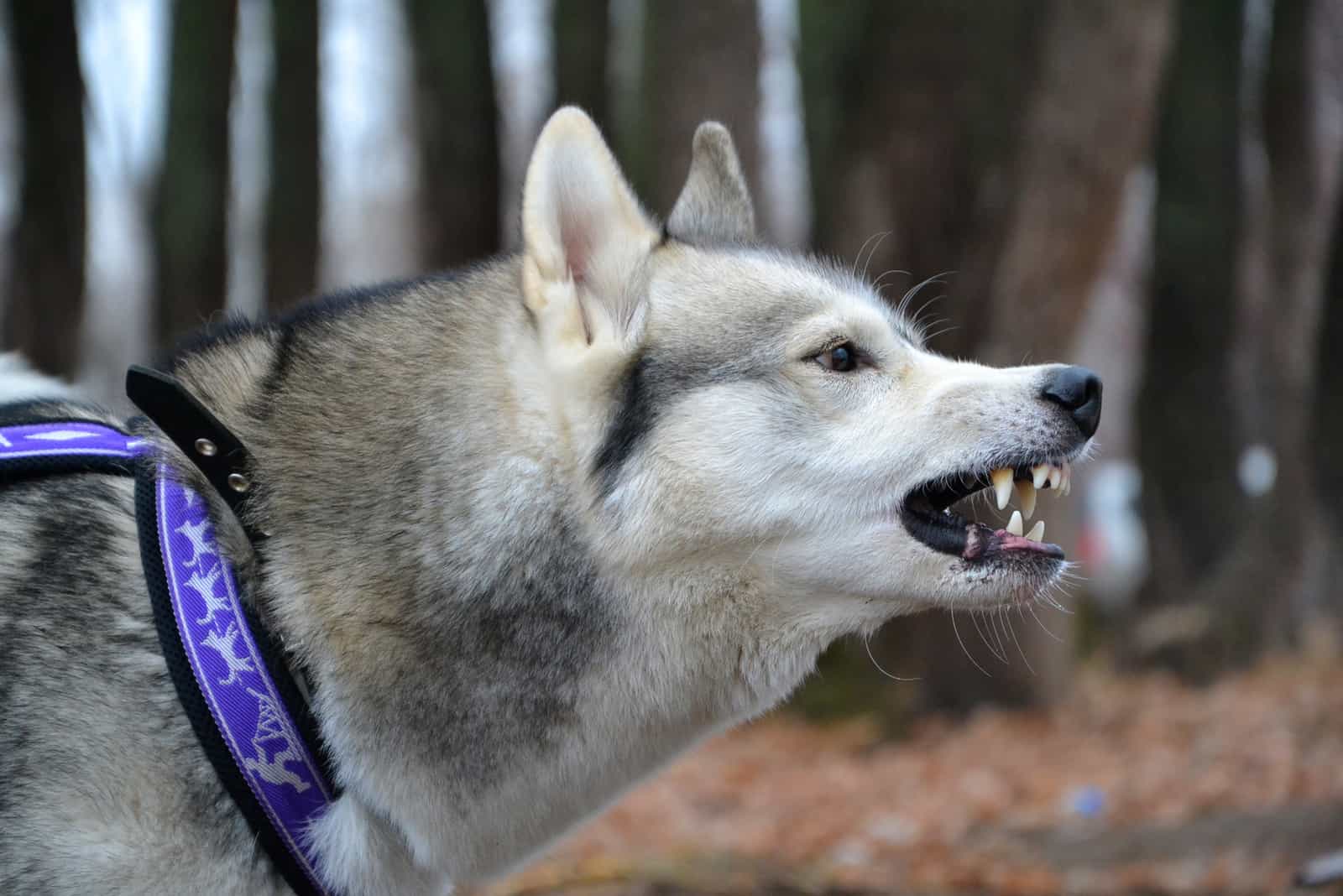
There are several causes behind a Husky’s aggressive behavior, ranging from territorial behavior to traumas from the past. These traumas might include cruel behavior or neglect from previous owners or the results of a dog attack.
If you’ve adopted your Husky from a shelter, the possibilities of the dog suffering from PTSD from some traumatic event are much higher than if you were to purchase him from an American Kennel Club (AKC) approved breeder.
We’ll go in-depth about the reasons behind aggression in a little while, but until then, it’s important to understand that while the reasons for aggression are diverse, you need to deal with this bad behavior as soon as possible.
You mustn’t tolerate any aggressive behavior, even for a minute. If you overlook or ignore the early signs of aggression, you might end up with a dangerous or even vicious dog.
Also, you should never challenge an aggressive dog as this might provoke an attack. At the same time, you shouldn’t play rough with it. While a game of fetch or frisbee is okay, forget about wrestling or tug-of-war! Any game that involves competition for dominance shouldn’t be played.
It’s important to understand the root of the problem before you can even attempt to ‘fix’ your dog. The moment that you notice your Siberian Husky starting to behave aggressively, observe him carefully and try to find the trigger.
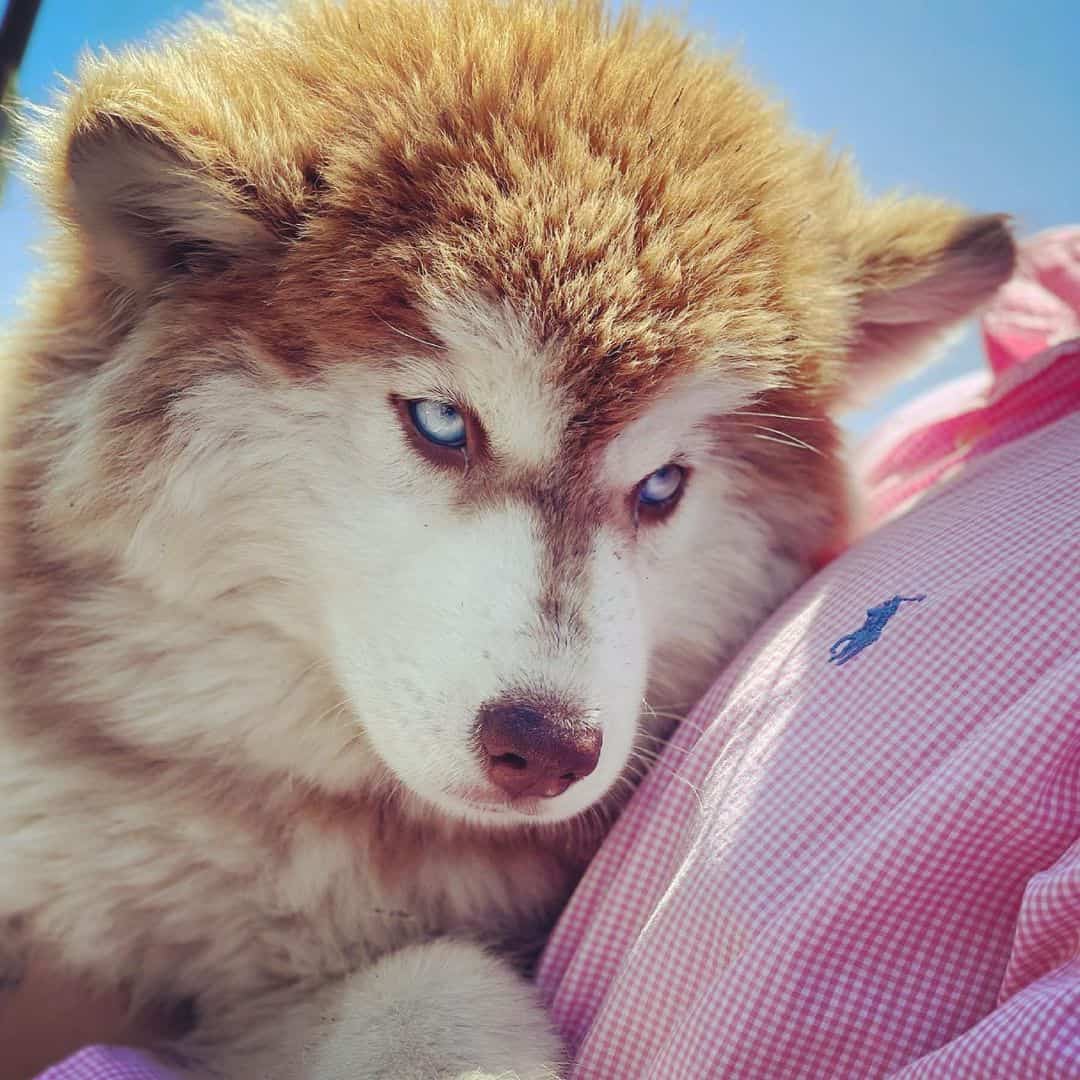
Photo from @huskiesdownsouth
Siberian Huskies rarely bark. Instead, they communicate by using body language and howling. When they want to assert dominance, they’ll try to appear as large as possible, with their chest out and ears pointed out.
If you notice these physical signs, don’t wonder if Huskies are aggressive – act immediately as your dog is about to act aggressively. You have to let your dog know that he is not a pack leader – you are.
Obedience classes can help you understand how to assert dominance over your dog. However, the best cure for this is to eliminate the cause, and because of this, you need to understand the trigger.
Of course, not all dog owners and Huskies are the same. You may not be able to determine what’s causing the aggression in your particular dog or how to deal with it adequately.
If this is the case, then it would be wise to contact a professional dog trainer who could provide your pup with correct obedience training.
Now, we’ll go over the most common causes of aggression in Siberian Huskies and how to deal with it.
Territorial Aggression
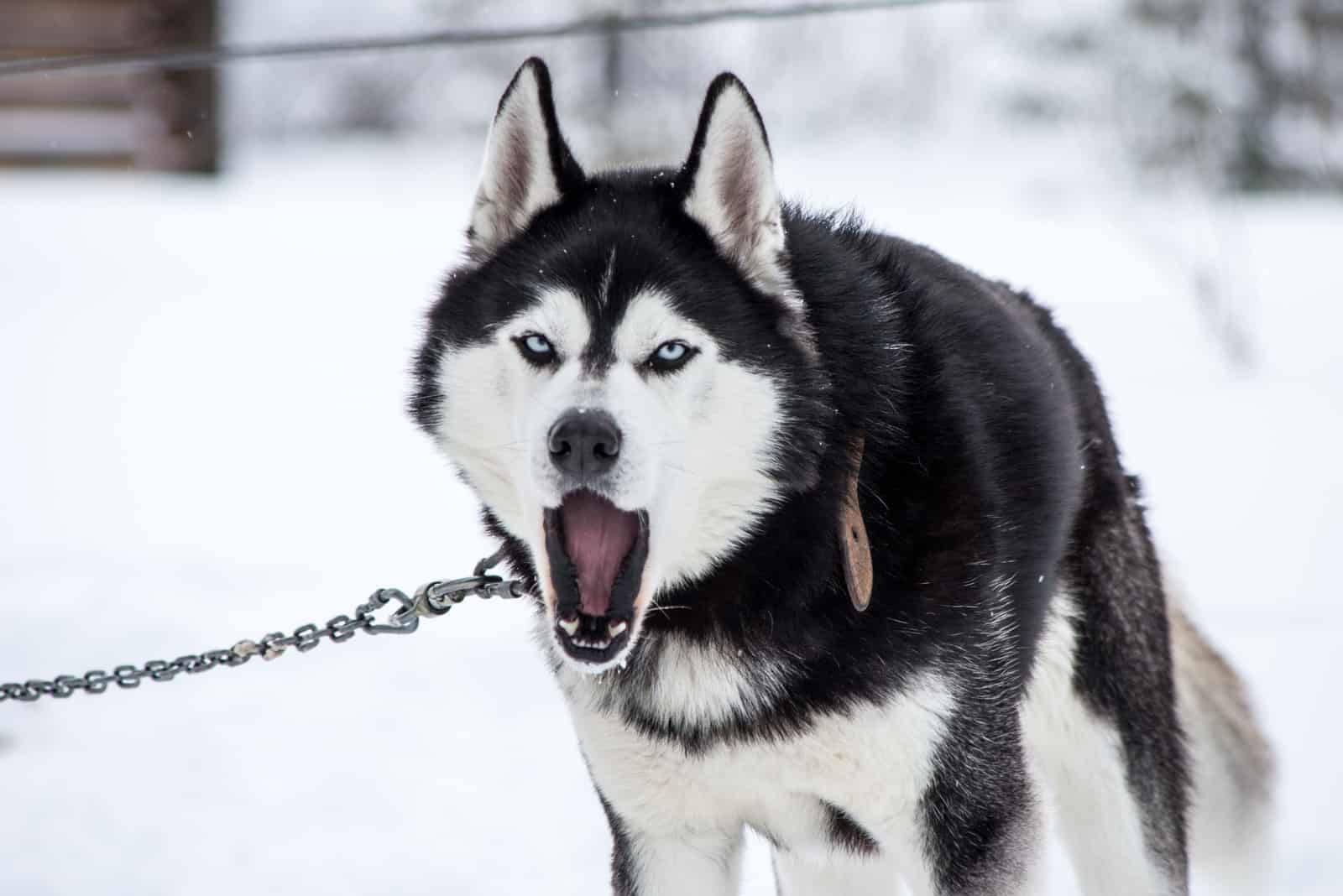
Some dogs tend to fiercely guard their homes. This is usually the owner’s mistake. You have to let your dog know that the home, the backyard, and their toys and food bowl aren’t his personal property. A dog that has territorial aggression is likely to bite.
While some dogs know how to determine the difference between welcomed guests and trespassers, others do not. However, Siberian Huskies are excellent at reading your attitude towards guests. For example, if you are afraid when someone walks in, they’ll sense that and get scared as well.
A dog that has territorial aggression will express several postures and behaviors that can be easily recognized if you know what to look for.
For example, a Husky dog will stand very tall, attempting to look as menacing as possible. It may even seem as if he’s trying to stand on the tip of his toes – however, the posture will remain rigid, so he can react instantly if he needs to. He might even lean forward slightly.
If there is another dog that your Husky fears is endangering his personal belongings, he’ll stand over top of him.
His tail will be erect, possibly even quivering slightly, while his head will be straight with erect ears pointing forward. Without blinking, his eyes will be fixed at the person or animal that he considers a threat. Even his fur might be standing up in a line from his neck to the tail’s base!
While Huskies are known to be quiet dogs, in such instances, they might growl with their mouth closed.
To fix this bad behavior, you need to let your dog know that you are the leader. Your Siberian Husky needs to know that he cannot be aggressive without your instructions.
Also, socialize your Husky from puppyhood, so he can learn that new people and animals are not a threat. Take your dog on long walks, and don’t take him off-leash when he’s meeting strangers. This way, he’ll get used to new situations and environments.
Another thing you should do to prevent territorial aggression is to let your dog know he doesn’t own anything. You are the one who owns both your property and his toys, and he only has them because you’re allowing him to.
Once your pet dog understands that he doesn’t own anything, he’ll have no possessions to fight over. This means that there will be no reason for him to be territorially aggressive.
Dominance Aggression
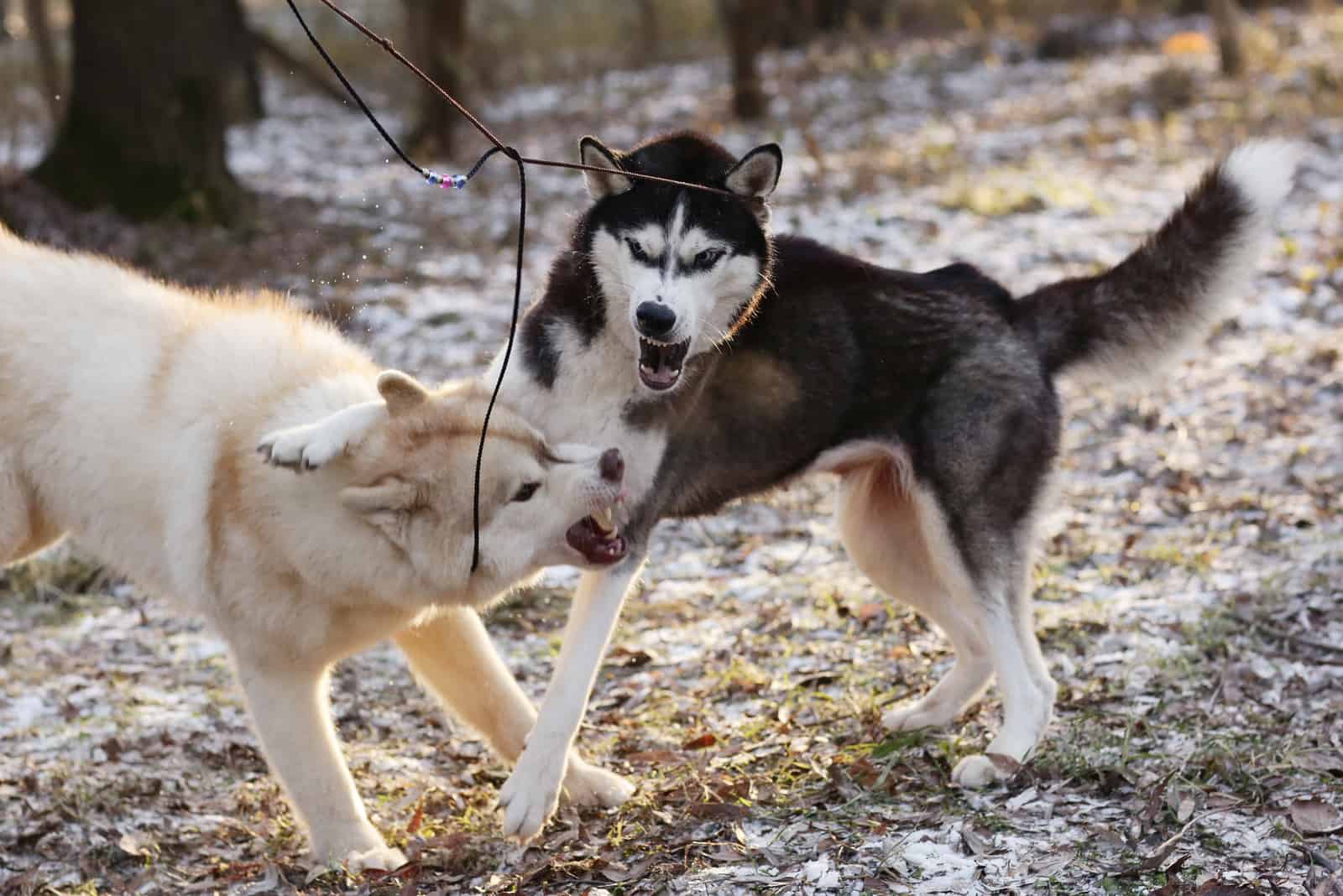
Another reason why your Husky might become aggressive is asserting dominance. Dominant dogs display behaviors of attempting to control people and animals in their environment. This usually includes mounting other dogs and people.
Dogs that are dominantly aggressive are also overly protective of their belongings and status, so they’ll often show signs of territorial aggression as well.
These dogs are not compliant with your requests, and will try to resist any control you try to impose on them. They’ll often display pushy behaviors such as snapping, growling, and sometimes even biting just to get their way.
If the dog feels powerful enough and you or another pet acts in such a way that can be understood as submissive, a dominant dog will become even worse in his attempts to prove that he is in charge.
To an overly dominant dog, aggression is a way of controlling everyone around them. They won’t hesitate to bite if this would mean that they are the ‘main dog in town’. Because of this, you should never get close to a dominant dog’s mouth when you’re trying to calm him down. Otherwise, you would be risking getting a dog bite.
A dominant adult Husky might be aggressive toward a new dog when they meet for the first time. They are dogs with high energy levels and a high prey drive, and they can be dangerous dogs toward smaller animals.
Believe it or not, female Huskies can often be more dominant than male Huskies, especially toward other females. A dog suffering from dominant aggression won’t hesitate to attack even your family members if he feels threatened.
Dominant aggression can usually be noticed from a pup’s young age. A dominant puppy might growl when you get close to his food bowl or if you or another puppy tries to take a toy away from him.
It is important to act quickly as this type of behavior will only get worse as time passes. Before you know it, a dominant dog will try to rule the house! This is why it’s important to know if Huskies are aggressive, so you will know how to tackle the issue.
Don’t make excuses for an aggressive puppy. Sure, he is ‘just a puppy’, but that’s precisely the point. If a pup is behaving aggressively, just think about what will happen when he becomes an adult dog! He won’t grow out of this behavior on his own.
Sure, you can deal with this when your dog is older, but this makes things a lot more challenging for you. In fact, this is the number one reason why dogs end up abandoned and in shelters or in humane societies.
Aggressive and dominant dogs are difficult to rehome, and unfortunately, they often have to be put to sleep.
To fix this issue, you have to show your dog that you’re the leader. Of course, you shouldn’t be aggressive – fighting aggression with aggression is never a good choice. You may want to contact an obedience trainer to help you with this. Check our advice on where to surrender an aggressive dog.
But firstly, you have to change the household dynamic and adopt strong leadership skills. Don’t play games where you need to fight for dominance, especially if your dog can win. Don’t give him food until he obeys a command. Don’t let your dog make their own choices; let him know that you’re the one in charge.
If dog training isn’t enough and you still fear that your dog is dangerous, get him a muzzle to keep you and other dogs safe from biting. Look in your local pet store or on Amazon to find a good muzzle for your dog’s size.
Make him exercise in the dog park more than usual as a tired dog will rarely be dominant. This is especially true with energetic dogs such as Huskies.
Finally, neutering will most likely help you deal with aggression as this will lower your doggy’s testosterone levels.
Predatory Aggression
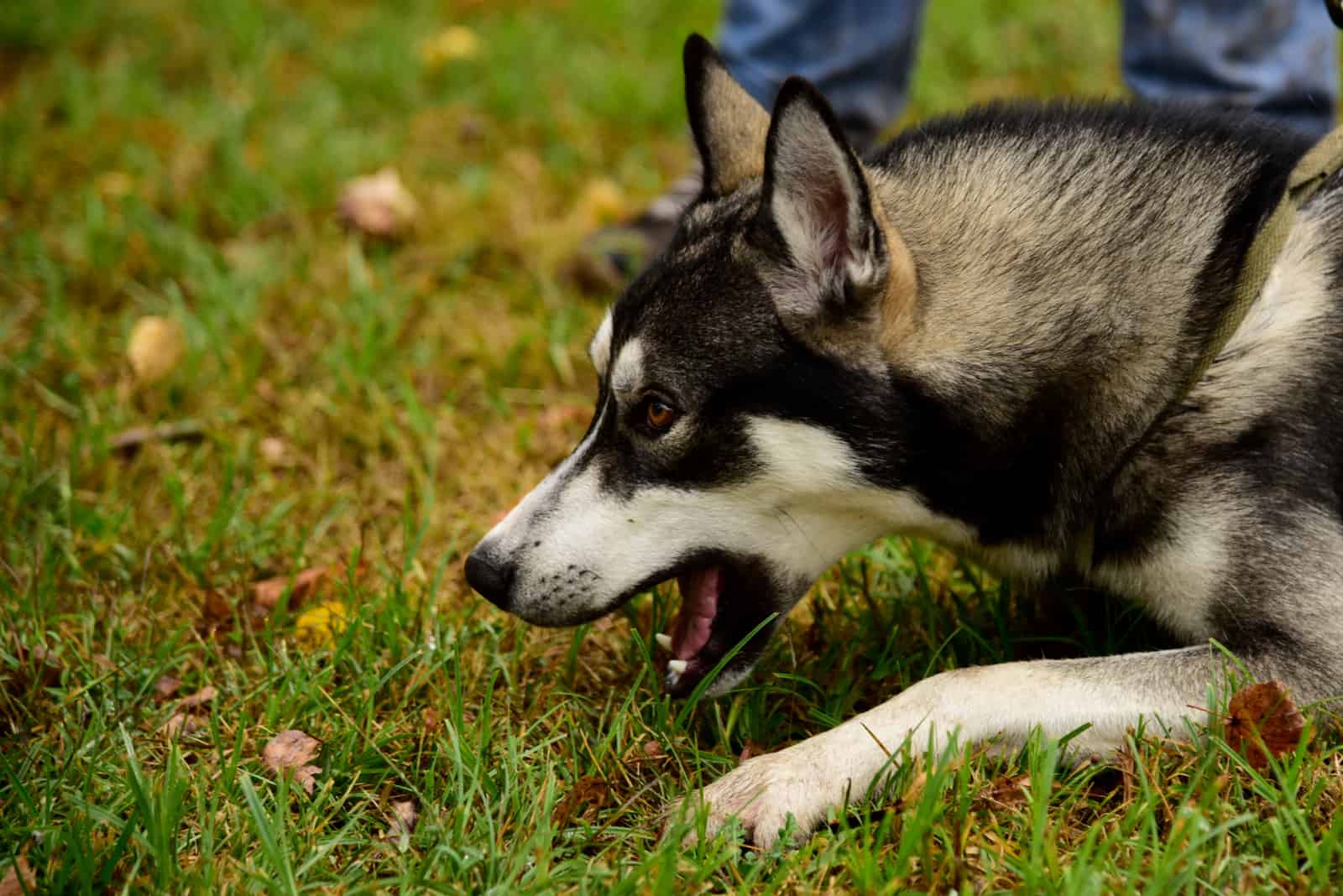
This is a problem for many working dogs such as Huskies and German Shepherds. Siberian Huskies have a strong prey drive, so they might feel triggered by the sight and sound of small animals and little children playing.
A good moment to notice your Husky’s prey drive is when he hurls in a group with other dogs. They have strong instincts that make them behave this way.
Even well-behaved Huskies might express aggressive tendencies when playing with small animals. This is why you have to socialize them as early as possible, so they get accustomed to playing with other pets.
Make sure that you let your Husky know he mustn’t be aggressive towards smaller animals, and teach it how to behave. Use positive reinforcements whenever they are friendly with other pets. With proper training, they can learn to act against their instincts.
At the same time, you need to teach your family members, especially your kids, how to behave around your new Husky puppy. While children mean well, they might trigger some aggressive behavior if they don’t know how to act respectfully towards pets.
Are Huskies Good Family Dogs?
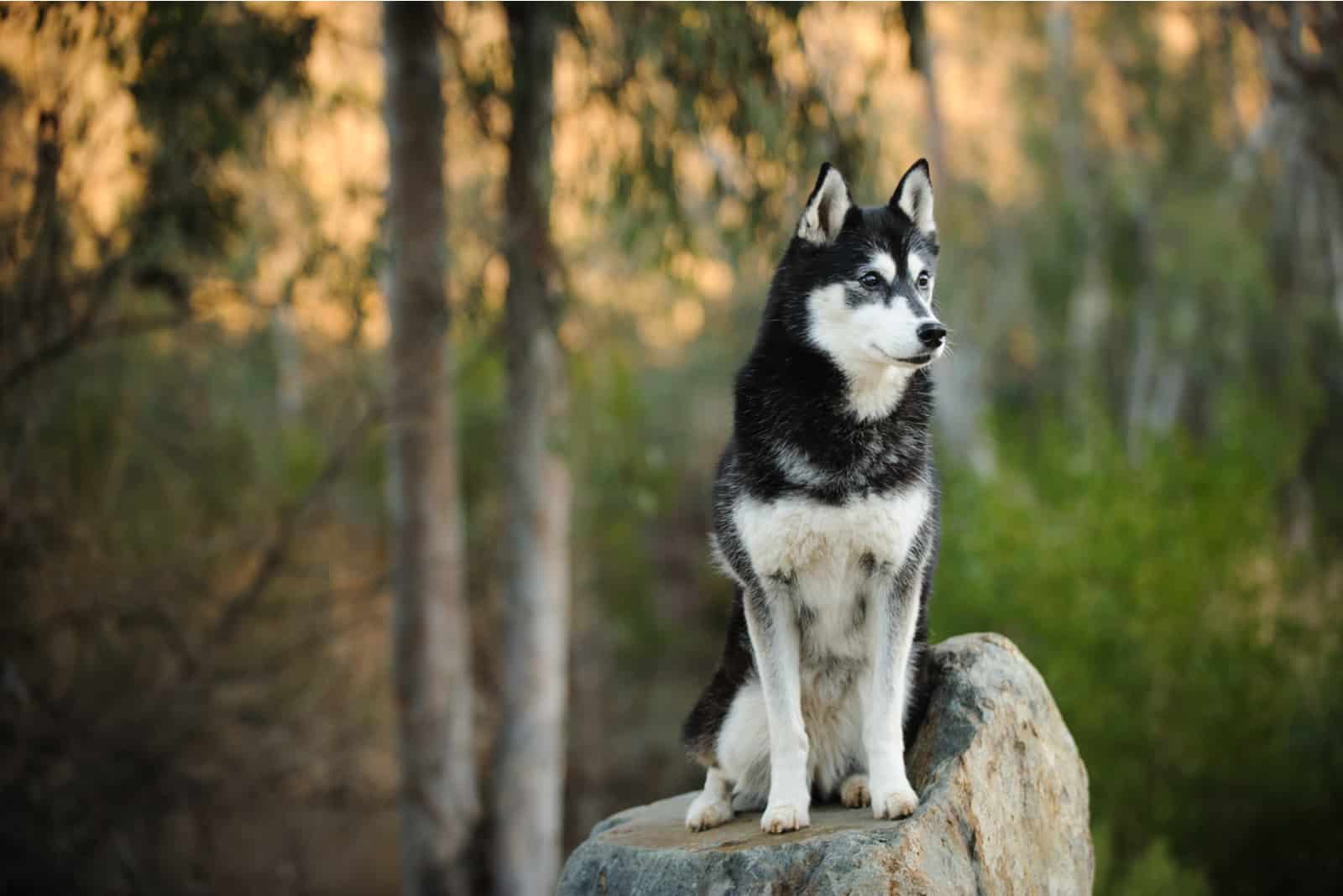
Now you know the answer to the question: “Are Huskies aggressive?”
Despite what we’ve just talked about, Huskies are amazing family dogs. They require some grooming, such as regular baths and brushing to avoid shedding, but they are overall very easy to maintain and to train.
Sure, all dogs can be aggressive, but this is usually the owner’s fault.
Overall, Huskies are friendly, playful dogs that love being around their family members. They will befriend everyone, and are always prepared to cuddle. They can even be excellent with kids as long as you teach them from puppyhood that children are family members.
If you notice that your puppy is showing signs of aggressive behavior, you should act as soon as possible. Training needs to begin as early as possible as it can be challenging to change the behavior of an adult dog.
Sometimes, though, normal puppy behaviors can be confused with aggression. For example, a puppy will bite more during teething. This doesn’t mean you should tolerate it, simply understand it. It takes a while until living with a Husky puppy becomes easy.
If your grown-up Husky is behaving aggressively, you shouldn’t give up on him. Dogs can unlearn bad behaviors. All it takes is some time and patience.
Of course, if you can’t deal with your dog on your own, you can always contact a professional dog trainer for help. These people know how to recognize the causes of aggression and can help you deal with them.
Without finding the root of the problem, you can’t fix the outcome. You need to understand your pup so that you can help him become the best version of himself.
